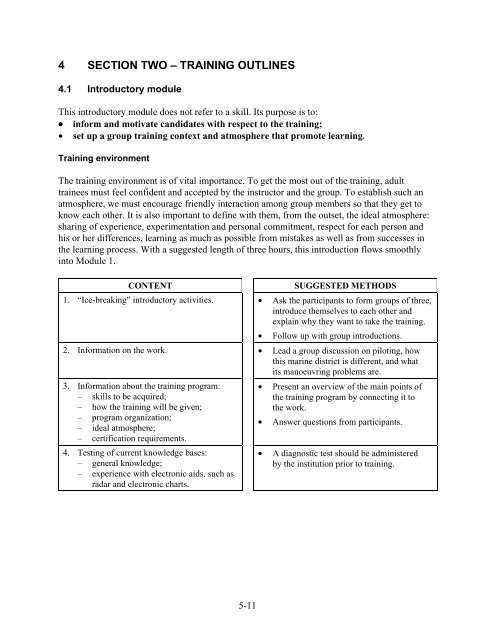District II Quebec City-Les Escoumins - Transports Canada
District II Quebec City-Les Escoumins - Transports Canada
District II Quebec City-Les Escoumins - Transports Canada
You also want an ePaper? Increase the reach of your titles
YUMPU automatically turns print PDFs into web optimized ePapers that Google loves.
4 SECTION TWO – TRAINING OUTLINES<br />
4.1 Introductory module<br />
This introductory module does not refer to a skill. Its purpose is to:<br />
• inform and motivate candidates with respect to the training;<br />
• set up a group training context and atmosphere that promote learning.<br />
Training environment<br />
The training environment is of vital importance. To get the most out of the training, adult<br />
trainees must feel confident and accepted by the instructor and the group. To establish such an<br />
atmosphere, we must encourage friendly interaction among group members so that they get to<br />
know each other. It is also important to define with them, from the outset, the ideal atmosphere:<br />
sharing of experience, experimentation and personal commitment, respect for each person and<br />
his or her differences, learning as much as possible from mistakes as well as from successes in<br />
the learning process. With a suggested length of three hours, this introduction flows smoothly<br />
into Module 1.<br />
CONTENT<br />
SUGGESTED METHODS<br />
1. “Ice-breaking” introductory activities. • Ask the participants to form groups of three,<br />
introduce themselves to each other and<br />
explain why they want to take the training.<br />
• Follow up with group introductions.<br />
2. Information on the work. • Lead a group discussion on piloting, how<br />
this marine district is different, and what<br />
its manoeuvring problems are.<br />
3. Information about the training program:<br />
– skills to be acquired;<br />
– how the training will be given;<br />
– program organization;<br />
– ideal atmosphere;<br />
– certification requirements.<br />
4. Testing of current knowledge bases:<br />
– general knowledge;<br />
– experience with electronic aids, such as<br />
radar and electronic charts.<br />
• Present an overview of the main points of<br />
the training program by connecting it to<br />
the work.<br />
• Answer questions from participants.<br />
• A diagnostic test should be administered<br />
by the institution prior to training.<br />
5-11
















